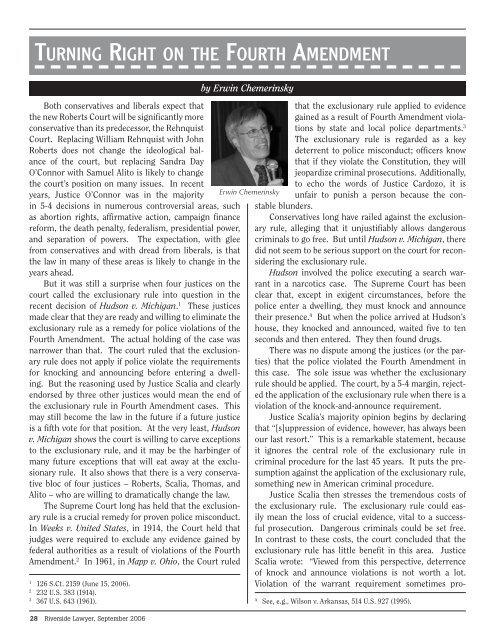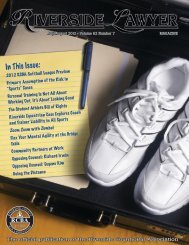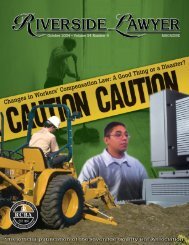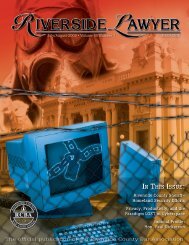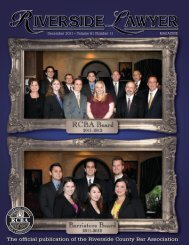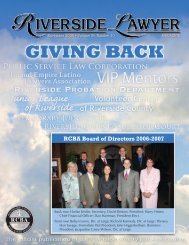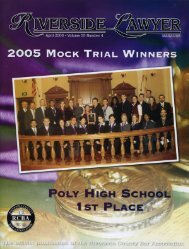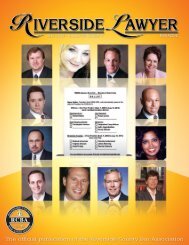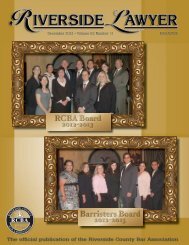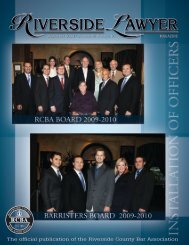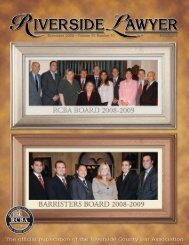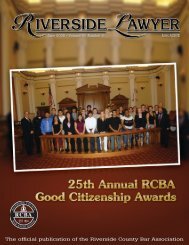THE JOHN GABBERT GALLERY - Riverside County Bar Association
THE JOHN GABBERT GALLERY - Riverside County Bar Association
THE JOHN GABBERT GALLERY - Riverside County Bar Association
Create successful ePaper yourself
Turn your PDF publications into a flip-book with our unique Google optimized e-Paper software.
Turning Right on the Fourth Amendment<br />
Both conservatives and liberals expect that<br />
the new Roberts Court will be significantly more<br />
conservative than its predecessor, the Rehnquist<br />
Court. Replacing William Rehnquist with John<br />
Roberts does not change the ideological balance<br />
of the court, but replacing Sandra Day<br />
O’Connor with Samuel Alito is likely to change<br />
the court’s position on many issues. In recent<br />
years, Justice O’Connor was in the majority<br />
in 5-4 decisions in numerous controversial areas, such<br />
as abortion rights, affirmative action, campaign finance<br />
reform, the death penalty, federalism, presidential power,<br />
and separation of powers. The expectation, with glee<br />
from conservatives and with dread from liberals, is that<br />
the law in many of these areas is likely to change in the<br />
years ahead.<br />
But it was still a surprise when four justices on the<br />
court called the exclusionary rule into question in the<br />
recent decision of Hudson v. Michigan. 1 These justices<br />
made clear that they are ready and willing to eliminate the<br />
exclusionary rule as a remedy for police violations of the<br />
Fourth Amendment. The actual holding of the case was<br />
narrower than that. The court ruled that the exclusionary<br />
rule does not apply if police violate the requirements<br />
for knocking and announcing before entering a dwelling.<br />
But the reasoning used by Justice Scalia and clearly<br />
endorsed by three other justices would mean the end of<br />
the exclusionary rule in Fourth Amendment cases. This<br />
may still become the law in the future if a future justice<br />
is a fifth vote for that position. At the very least, Hudson<br />
v. Michigan shows the court is willing to carve exceptions<br />
to the exclusionary rule, and it may be the harbinger of<br />
many future exceptions that will eat away at the exclusionary<br />
rule. It also shows that there is a very conservative<br />
bloc of four justices – Roberts, Scalia, Thomas, and<br />
Alito – who are willing to dramatically change the law.<br />
The Supreme Court long has held that the exclusionary<br />
rule is a crucial remedy for proven police misconduct.<br />
In Weeks v. United States, in 1914, the Court held that<br />
judges were required to exclude any evidence gained by<br />
federal authorities as a result of violations of the Fourth<br />
Amendment. 2 In 1961, in Mapp v. Ohio, the Court ruled<br />
by Erwin Chemerinsky<br />
Erwin Chemerinsky<br />
that the exclusionary rule applied to evidence<br />
gained as a result of Fourth Amendment violations<br />
by state and local police departments. 3<br />
The exclusionary rule is regarded as a key<br />
deterrent to police misconduct; officers know<br />
that if they violate the Constitution, they will<br />
jeopardize criminal prosecutions. Additionally,<br />
to echo the words of Justice Cardozo, it is<br />
unfair to punish a person because the constable<br />
blunders.<br />
Conservatives long have railed against the exclusionary<br />
rule, alleging that it unjustifiably allows dangerous<br />
criminals to go free. But until Hudson v. Michigan, there<br />
did not seem to be serious support on the court for reconsidering<br />
the exclusionary rule.<br />
Hudson involved the police executing a search warrant<br />
in a narcotics case. The Supreme Court has been<br />
clear that, except in exigent circumstances, before the<br />
police enter a dwelling, they must knock and announce<br />
their presence. 4 But when the police arrived at Hudson’s<br />
house, they knocked and announced, waited five to ten<br />
seconds and then entered. They then found drugs.<br />
There was no dispute among the justices (or the parties)<br />
that the police violated the Fourth Amendment in<br />
this case. The sole issue was whether the exclusionary<br />
rule should be applied. The court, by a 5-4 margin, rejected<br />
the application of the exclusionary rule when there is a<br />
violation of the knock-and-announce requirement.<br />
Justice Scalia’s majority opinion begins by declaring<br />
that “[s]uppression of evidence, however, has always been<br />
our last resort.” This is a remarkable statement, because<br />
it ignores the central role of the exclusionary rule in<br />
criminal procedure for the last 45 years. It puts the presumption<br />
against the application of the exclusionary rule,<br />
something new in American criminal procedure.<br />
Justice Scalia then stresses the tremendous costs of<br />
the exclusionary rule. The exclusionary rule could easily<br />
mean the loss of crucial evidence, vital to a successful<br />
prosecution. Dangerous criminals could be set free.<br />
In contrast to these costs, the court concluded that the<br />
exclusionary rule has little benefit in this area. Justice<br />
Scalia wrote: “Viewed from this perspective, deterrence<br />
of knock and announce violations is not worth a lot.<br />
Violation of the warrant requirement sometimes pro-<br />
1<br />
126 S.Ct. 2159 (June 15, 2006).<br />
2<br />
232 U.S. 383 (1914).<br />
3<br />
367 U.S. 643 (1961).<br />
4<br />
See, e.g., Wilson v. Arkansas, 514 U.S. 927 (1995).<br />
28 <strong>Riverside</strong> Lawyer, September 2006


